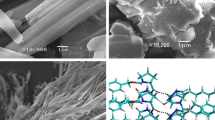Conclusions
-
1.
A new approach to the investigation of freshly precipitated Fe3+ hydrogels, based on the concepts of the polymer structure of the primary particles of the precipitate, was developed.
-
2.
A new methodology was proposed for the study of the processes of formation and properties of precipitates of Fe3+ hydrogels, constructed on the basis of a combination of the methods of chemical and complex thermal analysis.
-
3.
The composition of the primary particles is determined by the conditions of formation of the precipitates. At pH below 7.5, the primary particles contain anions of the salt as an element bearing a structural load, and not only playing the role of a counter ion.
-
4.
A mechanism was proposed for the formation of primary particles of precipitates of Fe3+ hydrogels from polymer subunits with the structure and composition characteristic of the given hydroxide.
Similar content being viewed by others
Literature cited
R. A. Buyanov, O. P. Krivoruchko, and I. A. Ryzhak, Kinetika i Kataliz,13, 470 (1972).
I. A. Ryzhak, O. P. Krivoruchko, R. A. Buyanov, L. M. Kefeli, and A. A. Ostan'kovich, Kinetika i Kataliz,10, 377 (1969).
R. A. Buyanov, O. P. Krivoruchko, and A. A. Ostan'kovich, Kinetika i Kataliz,13, 1094 (1972).
R. A. Buyanov and I. A. Ryzhak, Kinetika i Kataliz,14, 1265 (1973).
L. G. Berg, Introduction to Thermography [Russian translation], Nauka (1969), p. 157.
N. Bjerrum, Z. Phys. Chemie,59, 336 (1907).
G. Jander and A. Winkel, Z. Anoggan. und Allgem. Chem.,193, 1 (1930).
L. G. Sillen and A. E. Martell, Stability Constants of Metal-Ion Complexes, London (1964).
T. G. Spiro, S. E. Allerton, J. Renner, A. Terzis, R. Bus, and P. Saltman, J. Aner. Chem, Soc.,88, 2721 (1966).
J. J. Fripiat and M. Penneguin, Bull. Soc, Chim. France,6, 1655 (1965).
A. A. Giessen, J. Phys. Chem, Solids,28, 343 (1967).
K. A. Burkov and L. S. Lilich, in: Problems of the Modern Chemistry of Coordination Compounds [in Russian], No. 2, Izd-vo Leningr. Un-ta (1968), p. 134.
A. V. Karyakin and R. A. Kriventsova, The State of Water in Organic and Inorganic Compounds [in Russian], Nauka (1973).
G. W. van-Oosterhout, Acta Crystallogr.,13, 932 (1960).
B. K. Lippens and I. I. Steggerda, Structure and Properties of Adsorbents and Catalysts [Russian translation], Mir (1973), p. 190.
Author information
Authors and Affiliations
Additional information
Translated from Izvestiya Akademii Nauk SSSR, Seriya Khimicheskaya, No. 7, pp. 1460–1467, July, 1974.
Rights and permissions
About this article
Cite this article
Krivoruchko, O.P., Buyanov, R.A., Zolotovskii, B.P. et al. Investigation of the properties of primary polymer particles of freshly precipitated Fe3+ hydrogels. Russ Chem Bull 23, 1384–1389 (1974). https://doi.org/10.1007/BF00929635
Received:
Issue Date:
DOI: https://doi.org/10.1007/BF00929635




